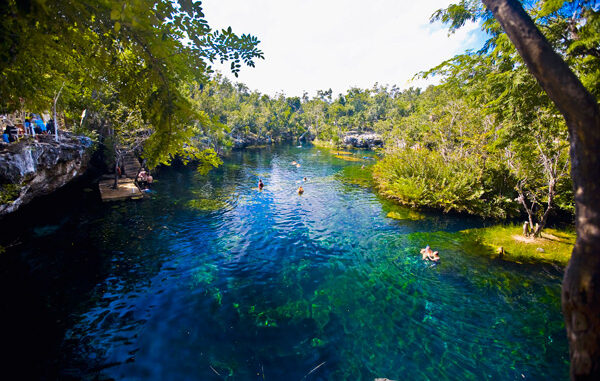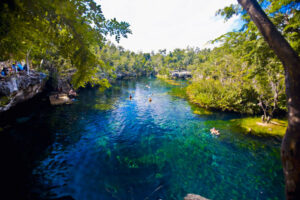

Rodrigo Torres/Glow Images
Cenote divers
I am swimming in the warm waters of a beautiful and crystal-clear natural pond. I look up to see remarkable rock formations and stalactites that resemble works of art. A beam of sunlight streams down onto the turquoise water. I feel like I am in a magical place. Where am I?
I am in a cenote in the middle of the jungle, on the Yucatán Peninsula. The Yucatán is a favorite destination for snorkelers and scuba divers because of its vast network of cenotes, underwater caverns, and caves—the longest underwater cave system on Earth! One underground river, with all of its twists and turns, measures ninety-five miles through the region’s limestone cave system.
Cenotes are the naturally occurring freshwater ponds that serve as entranceways to the massive underground caves and rivers. There are more than 6,000 cenotes in the Yucatán Peninsula! They come in a variety of sizes—from a small hole to more than 600 feet wide. The word cenote is the Spanish variation of the Mayan word dzonot, which means “deep sacred well.” This extensive water system served the Maya for centuries. Cenotes provided such an essential natural resource that the ancient Maya built their towns around them and included them in their religious rituals. Today, this vast network remains a main source of freshwater for the region.

©Sami Sarkis/Photodisc/Getty Images
Exploring an underwater cave
Cenotes and their caverns and caves are very popular for scuba divers and snorkelers because the water temperature stays around 77°F, and the water is very clear and still, so there is excellent visibility. The cenotes tend to have interesting names. A few of the major cenotes are Dos Ojos, Ponderosa, Taj Mahal, and Temple of Doom. Are you daring enough to explore the Temple of Doom? Near Tulúm, at the end of a rugged unmarked jungle path, the Temple of Doom consists of three cenotes, which together create the shape of a skull. Remember that scuba diving through a labyrinth of caverns and caves can be extremely dangerous. You need to go with an experienced guide who is familiar with all the passages and who has special equipment. ¡Buen viaje!
Explore More:
1. Research more specifically one of the cenotes mentioned in the article, or find another one that interests you. Prepare a report for the class, with visuals if possible. You may want to expand your study by exploring additional interesting aspects of the cenotes and caves, such as the flora and fauna, or why the water looks turquoise. If each classmate learns about a different cenote, you could combine all the information into a cenote Which cenote looks the most interesting to visit?
2. Investigate further the role of cenotes in the Mayan civilization. How else were they used besides as a water source? Why did the Maya believe them to be sacred?
3. Research caves in the United States. How do they compare with the cave system in the Yucatán Peninsula?
4. The rapid pace of new development along the Yucatán coastline is threatening the area’s freshwater supply. Contaminants leach through the limestone rock and into the groundwater that is transported throughout the underground cave system. There are projects underway to study this growing problem. For example, the Quintana Roo Underwater Cave Project has sent scientists to explore, examine, and map the underwater caves. Delve further into what is being done to correct the pollution problem. There are many fascinating and educational videos on the Internet that show divers and scientists exploring the underground waterways and caves.
Share What You Know:
1. Have you ever gone snorkeling or scuba diving? If not, would you like to? Explain. If you have, describe your experience. Where did you go? Did you find it fun or scary?
2. The hobby of exploring caves is called Have you ever gone spelunking? If so, what about it did you find interesting? Would you do it again?
3. If you have studied the formation of caves in science or geology class, share what you have learned with the class.
4. If you were to go on a vacation to the Yucatán Peninsula, would you want to visit a cenote? Why or why not? Would you limit yourself to swimming in a cenote? Would you be more adventurous and explore the caverns below? Would you be a daredevil and face the challenge of the deepest caves? What would you do to make it a safe, educational, fun, and rewarding experience? Survey the class and chart your classmates’ answers.